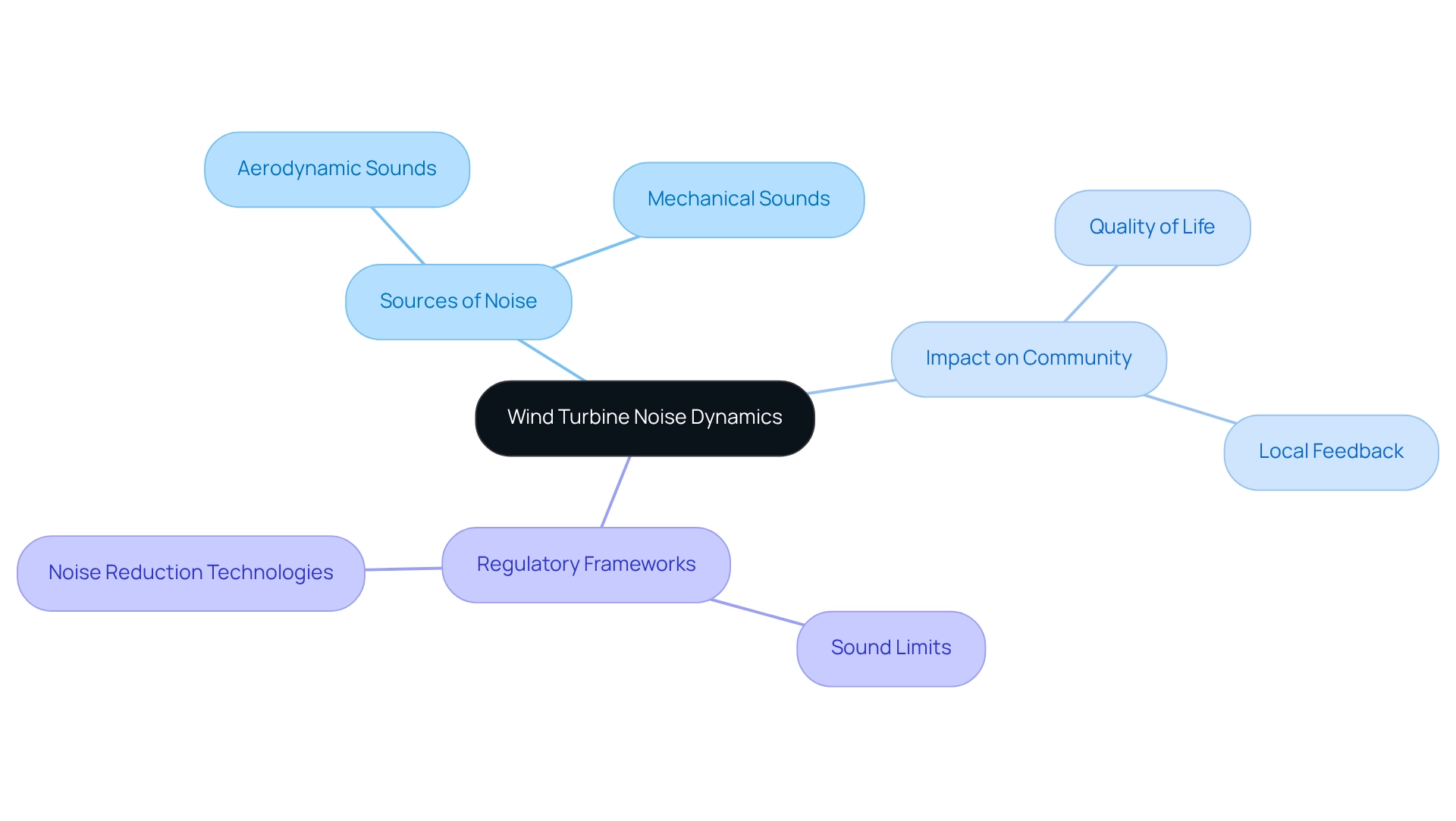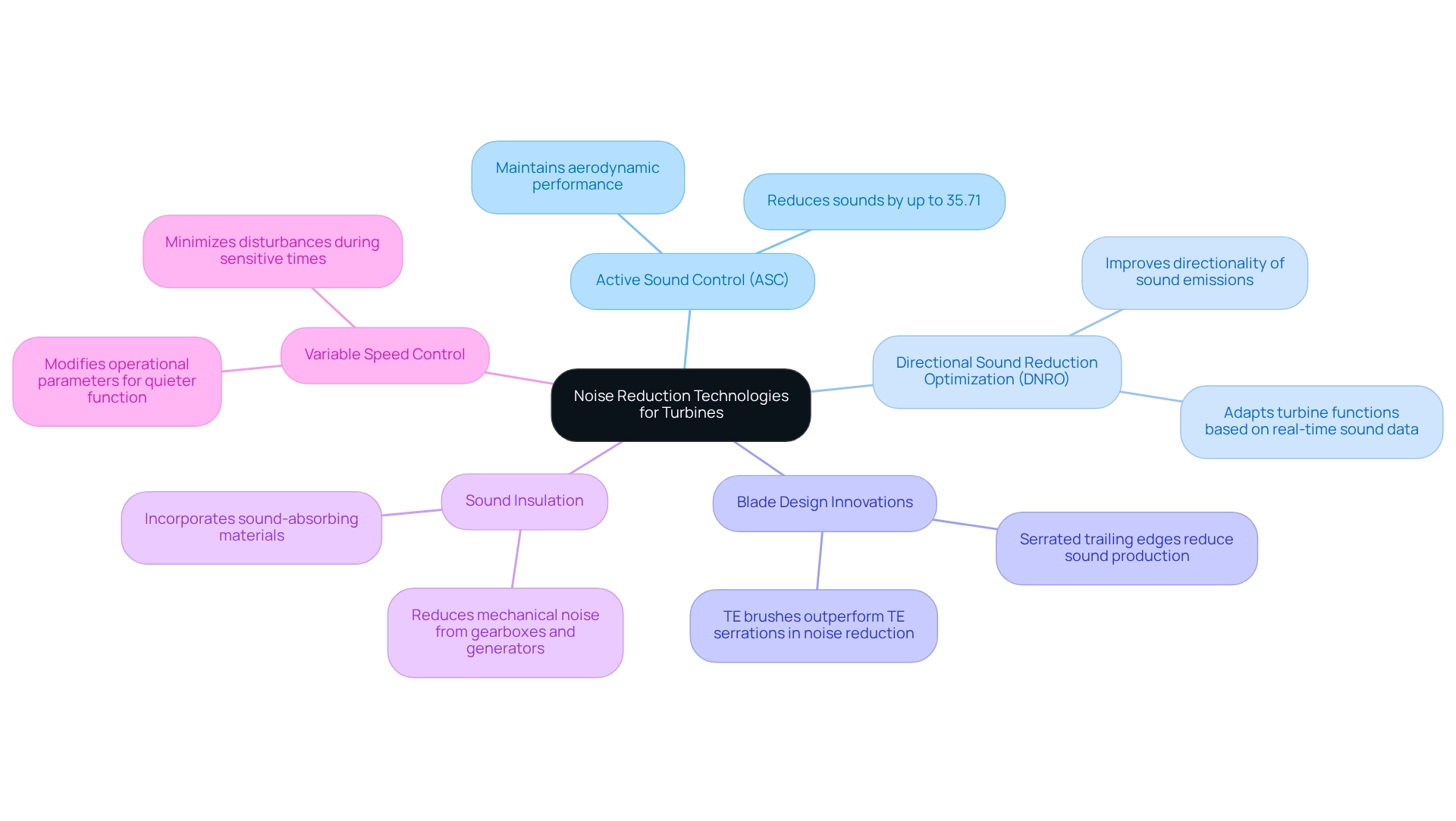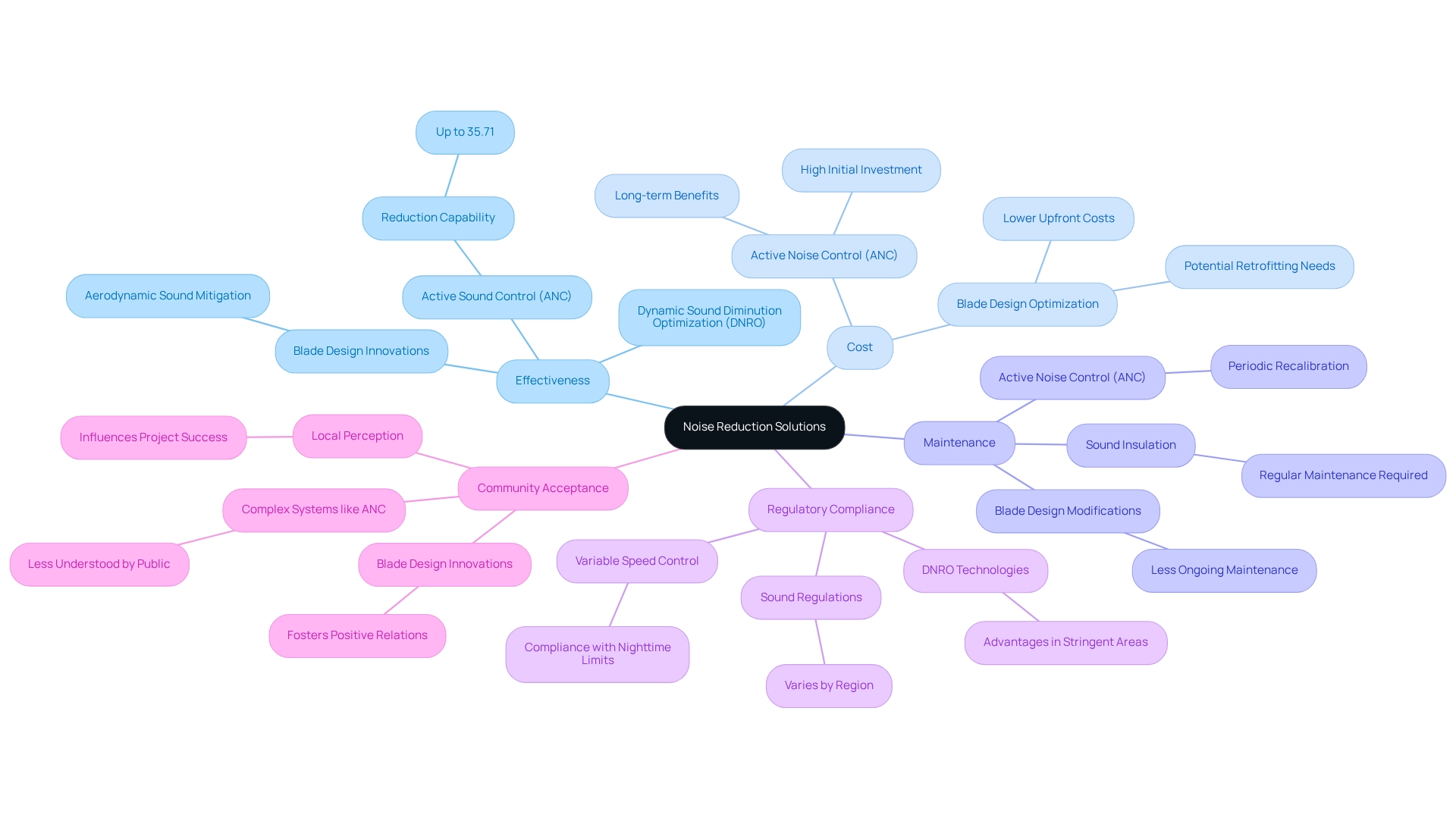Overview
Noise reduction technologies for turbines are crucial for addressing the sound generated by wind generators. These advancements primarily stem from innovations in blade design, active sound control, and sound insulation methods. Effective sound reduction not only alleviates community concerns regarding noise pollution but also ensures compliance with regulatory frameworks. This dual benefit ultimately fosters greater acceptance of wind energy projects among local residents.
Introduction
In the pursuit of sustainable energy, wind turbines represent a formidable solution; however, they frequently present a notable challenge: noise. Grasping the intricacies of wind turbine noise is crucial for addressing community concerns and enhancing project acceptance. This article investigates the origins of turbine noise, encompassing both aerodynamic and mechanical factors, and examines innovative technologies aimed at alleviating these disturbances.
By analyzing various noise reduction strategies and their effectiveness, stakeholders can adeptly navigate the complexities of wind energy projects while nurturing positive relationships with local communities.
As the industry progresses, the equilibrium between efficient energy production and community well-being remains a critical challenge.
Understanding Wind Turbine Noise Dynamics
Wind generator sounds primarily stem from two key sources: aerodynamic sounds and mechanical sounds. Aerodynamic sound occurs when air interacts with the blades, particularly at the tips where velocities peak, generating a distinctive whooshing sound that fluctuates with wind speed and blade design. Conversely, mechanical sounds arise from the turbine's internal components, such as the gearbox and generator. Understanding these dynamics is crucial for developing targeted sound reduction strategies, especially through the implementation of noise reduction technologies for turbines, which can effectively address specific auditory sources. Notably, advancements in blade design have shown promise in significantly mitigating aerodynamic sound, while sound insulation techniques are more suitable for reducing mechanical sound.
Recent research in 2025 has highlighted the importance of community input in energy project planning. Residents like Wendy Todd from Mars Hill, ME, have reported that nearby turbines disrupt her family's quality of life and sleep patterns, emphasizing the broader implications of community concerns in project execution. This situation underscores the necessity for energy developers to incorporate local feedback when planning new projects. Furthermore, regulatory frameworks play a vital role in shaping sound management strategies within the renewable energy sector. Regulations that set sound limits and mandate evaluations have driven the adoption of advanced noise reduction technologies for turbines and improved operational practices in wind farms. For instance, the case study titled 'Regulatory Impact on Wind Farm Sound Management' demonstrates how specific regulations influence sound management practices, ensuring that community concerns are duly considered.
As noted by Nick Archer, Regional Director with the Maine Department of Environmental Protection, 'This is a problem.' He emphasizes, 'We need to figure out what is going on with these things before we go putting anymore of them up.' This statement underscores the necessity for ongoing research and development in sound dynamics to enhance community acceptance and ensure project success.

Exploring Noise Reduction Technologies for Turbines
Innovative sound reduction technologies have emerged to address the challenges related to wind generators, each providing unique benefits.
Active Sound Control (ASC) utilizes sensors to monitor sound levels, generating anti-sound signals that can reduce unwanted sounds by up to 35.71%. This technology efficiently eliminates sound using noise reduction technologies for turbines without sacrificing aerodynamic performance, making it an essential tool in contemporary engine design.
Directional Sound Reduction Optimization (DNRO) improves the directionality of sound emissions, significantly reducing the impact on nearby communities. By modifying turbine functions according to real-time sound information, DNRO guarantees a more harmonious coexistence with local residents.
Blade Design Innovations, such as serrated trailing edges, have proven effective in decreasing sound production at the source. Finez et al. (2010) demonstrated that TE brushes instead of TE serrations provide better outcomes in terms of sound reduction. These aerodynamic improvements can lead to a significant reduction in overall noise levels generated by machines, showcasing the effectiveness of noise reduction technologies for turbines in contributing to quieter energy generation.
Sound Insulation involves the incorporation of sound-absorbing materials within machinery structures, helping to reduce mechanical noise, particularly from components like gearboxes and generators. This insulation is crucial for enhancing the overall acoustic performance of turbines, especially when implementing noise reduction technologies for turbines.
Variable Speed Control modifies operational parameters in response to changing atmospheric conditions, enabling turbines to function more quietly during sensitive times, such as nighttime. This adaptability is essential for minimizing disturbances in residential areas. Each of these technologies presents unique benefits and challenges, underscoring the importance of evaluating their effectiveness in diverse contexts. Recent studies suggest that merging blade modifications with ANC can result in a substantial decrease of 28.41%, while also enhancing the lift-to-drag ratio by 0.41%. As the sector advances, continuous research and development will keep enhancing these technologies, guaranteeing that air energy remains a sustainable and community-friendly power source.
As we approach the Australia Air Energy 2025 event on July 17, 2025, these improvements in sound mitigation technologies will be vital subjects of conversation. Bob Dylan's quote about the elusive nature of answers found in wind energy resonates here, reminding us that while we strive for innovation, the journey to quieter and more efficient energy production is ongoing.

Comparative Analysis of Noise Reduction Solutions
A comprehensive analysis of sound attenuation technologies reveals several essential criteria for assessment:
- Effectiveness: Active Sound Control (ANC) and Dynamic Sound Diminution Optimization (DNRO) technologies exhibit remarkable sound attenuation capabilities, with ANC achieving reductions of up to 35.71%. Advancements in blade design play a crucial role, particularly in mitigating aerodynamic sound at the source, thereby enhancing the overall performance of the system. Notably, research indicates that the visibility of wind generators adversely affects self-reported sleep disruption, underscoring the necessity for noise reduction technologies in turbines.
- Cost: The adoption of advanced technologies like ANC can incur significant expenses due to the requirement for sophisticated sensors and control systems. Detailed cost analyses for implementing Active Noise Control in energy projects indicate that while initial investments may be considerable, the long-term benefits can justify the expenditure. In contrast, optimizing blade design may involve lower upfront costs, although it could necessitate more extensive retrofitting efforts to achieve desired outcomes.
- Maintenance: Technologies such as sound insulation often require regular maintenance to sustain their effectiveness, whereas ANC systems may require periodic recalibration to ensure optimal performance. Conversely, once modifications to blade design are made, they typically demand less ongoing maintenance, rendering them a more sustainable option in the long run. This sustainability is further supported by case studies on the end-of-life management of wind energy blades, which highlight the need for advancements in design and recycling technologies.
- Regulatory Compliance: Sound regulations vary significantly across regions, impacting the selection of sound mitigation technologies. For example, noise reduction technologies for turbines, such as DNRO, may be particularly advantageous in areas with stringent sound ordinances. Additionally, variable speed control can help turbines comply with nighttime sound limits, thereby enhancing adherence to local regulations.
- Community Acceptance: The perception of sound mitigation technologies by the local population can greatly influence project success. Solutions that effectively reduce sound levels and foster positive community relations, such as blade design innovations, are often favored over more complex systems like ANC, which may be less understood by the public. As Kristy Hansen noted in her recent research, advancements in understanding wind turbine noise are vital for improving community relations and acceptance, especially through the application of noise reduction technologies for turbines. By thoroughly evaluating these criteria, stakeholders can gain valuable insights into which noise reduction technologies for turbines best align with their project objectives and community expectations, ultimately leading to more successful energy projects.

Conclusion
The dynamics of wind turbine noise present a significant challenge, driven by both aerodynamic and mechanical factors. A comprehensive understanding of these elements is essential for developing effective noise reduction strategies. Innovations in technology, such as Active Noise Control and advanced blade designs, have shown substantial promise in addressing the issues associated with turbine noise. These solutions not only enhance the acoustic performance of turbines but also aim to foster improved relationships with local communities impacted by wind energy projects.
Community feedback is crucial in shaping the planning and implementation of wind energy initiatives. Various case studies demonstrate that engaging with residents and addressing their concerns can lead to more successful project outcomes. Regulatory frameworks further guide the adoption of noise management practices, ensuring that energy developers remain compliant while prioritizing community well-being.
In conclusion, the balance between efficient energy production and community acceptance is a pivotal challenge for the wind energy sector. By prioritizing the development and implementation of innovative noise reduction technologies, stakeholders can navigate the complexities of project acceptance and support the transition to a more sustainable energy future. As the industry evolves, ongoing research and collaboration will be essential in achieving quieter, more efficient wind energy solutions that resonate positively within communities.
Frequently Asked Questions
What are the primary sources of sound generated by wind turbines?
The primary sources of sound from wind turbines are aerodynamic sounds and mechanical sounds. Aerodynamic sound is produced when air interacts with the blades, especially at the tips, creating a whooshing sound that varies with wind speed and blade design. Mechanical sounds come from the internal components of the turbine, such as the gearbox and generator.
How can aerodynamic sound be mitigated in wind turbines?
Aerodynamic sound can be significantly reduced through advancements in blade design, which have shown promise in minimizing the noise generated by the interaction of air with the blades.
What strategies are effective for reducing mechanical sound in wind turbines?
Mechanical sound can be reduced using sound insulation techniques, which are more suitable for addressing the noise produced by the turbine's internal components.
Why is community input important in energy project planning?
Community input is crucial because residents, like Wendy Todd from Mars Hill, ME, have expressed concerns that nearby turbines affect their quality of life and sleep patterns. Incorporating local feedback helps energy developers address these concerns when planning new projects.
What role do regulatory frameworks play in sound management for wind farms?
Regulatory frameworks are essential in shaping sound management strategies by setting sound limits and mandating evaluations. These regulations drive the adoption of advanced noise reduction technologies and improve operational practices in wind farms.
What does the case study 'Regulatory Impact on Wind Farm Sound Management' illustrate?
The case study demonstrates how specific regulations influence sound management practices, ensuring that community concerns are taken into account in the planning and operation of wind farms.
What is the significance of ongoing research in sound dynamics for wind energy projects?
Ongoing research in sound dynamics is important for enhancing community acceptance and ensuring the success of wind energy projects, as emphasized by experts like Nick Archer from the Maine Department of Environmental Protection.




